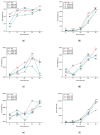Antioxidant Benefits and Potential Mechanisms of Slightly Acidic Electrolyzed Water Germination in Sesame
- PMID: 38002162
- PMCID: PMC10670595
- DOI: 10.3390/foods12224104
Antioxidant Benefits and Potential Mechanisms of Slightly Acidic Electrolyzed Water Germination in Sesame
Abstract
Slightly acidic electrolytic water (SAEW) treatment for seed germination is a promising technique for sustainable agriculture. This study investigated the antioxidant activity of germinated sesame seeds treated with SAEW for the first time. Specifically, the impact and correlation of SAEW on the activities of total phenols, total flavonoids, and antioxidant oxidase in sesame seeds were examined. The results showed that SAEW with low ACC inhibited sesame germination, SAEW with high ACC promoted sesame germination, and sesame buds treated with SAEW with 30 mg/L and 50 mg/L ACC showed lower antioxidant activity and total phenolic and flavone content compared to tap water. In contrast, SAEW with 30 mg/L ACC had no significant effect on sesame growth but positively influenced the antioxidant activity of sesame seed germination by promoting phenolic compound synthesis through increased phenylalanine ammonia-lyase (PAL) activity and enhancing antioxidant activity by boosting PAL, polyphenol oxidase (PPO), and peroxidase (POD) activities. Generally, antioxidant ability was the most prominent in SAEW with 30 mg/L ACC, and positive correlations between antioxidation and total phenols and flavonoids content were found in sesame. These findings provide valuable insights into the mechanisms underlying the enhanced antioxidant capacity observed in germinated sesame seeds under SAEW stress.
Keywords: antioxidant activity; antioxidant enzymes; sesame; slightly acidic electrolytic water.
Conflict of interest statement
The authors declare no conflict of interest.
Figures






Similar articles
-
Dual effects of slightly acidic electrolyzed water (SAEW) treatment on the accumulation of γ-aminobutyric acid (GABA) and rutin in germinated buckwheat.Food Chem. 2016 Jun 15;201:87-93. doi: 10.1016/j.foodchem.2016.01.037. Epub 2016 Jan 11. Food Chem. 2016. PMID: 26868552
-
Slightly Acidic Electrolyzed Water Treatment Enhances the Main Bioactive Phytochemicals Content in Broccoli Sprouts via Changing Metabolism.J Agric Food Chem. 2019 Jan 16;67(2):606-614. doi: 10.1021/acs.jafc.8b04958. Epub 2019 Jan 8. J Agric Food Chem. 2019. PMID: 30576129
-
Prevention of enzymatic browning of Chinese yam (Dioscorea spp.) using electrolyzed oxidizing water.J Food Sci. 2015 Apr;80(4):C718-28. doi: 10.1111/1750-3841.12820. Epub 2015 Mar 3. J Food Sci. 2015. PMID: 25736015
-
Effect of slightly acidic electrolyzed water on natural Enterobacteriaceae reduction and seed germination in the production of alfalfa sprouts.Food Microbiol. 2021 Aug;97:103414. doi: 10.1016/j.fm.2020.103414. Epub 2020 Jan 9. Food Microbiol. 2021. PMID: 33653513
-
Inactivation mechanism of slightly acidic electrolyzed water on Bacillus cereus spores.Food Microbiol. 2022 May;103:103951. doi: 10.1016/j.fm.2021.103951. Epub 2021 Nov 24. Food Microbiol. 2022. PMID: 35082068
Cited by
-
Modification of Physiochemical and Techno-Functional Properties of Stink Bean (Parkia speciosa) by Germination and Hydrothermal Cooking Treatment.Foods. 2023 Dec 14;12(24):4480. doi: 10.3390/foods12244480. Foods. 2023. PMID: 38137284 Free PMC article.
References
-
- Khan T.A., Hassan I., Ahmad A., Perveen A., Aman S., Quddusi S., Alhazza I.M., Ashraf G.M., Aliev G. Recent Updates on the Dynamic Association between Oxidative Stress and Neurodegenerative Disorders. CNS Neurol. Disord.-Drug Targets. 2016;15:310–320. doi: 10.2174/1871527315666160202124518. - DOI - PubMed
-
- Alfa H.H., Arroo R.R.J. Over 3 decades of research on dietary flavonoid antioxidants and cancer prevention: What have we achieved? Phytochem. Rev. 2019;18:989–1004. doi: 10.1007/s11101-019-09632-0. - DOI
Grants and funding
LinkOut - more resources
Full Text Sources
Miscellaneous

